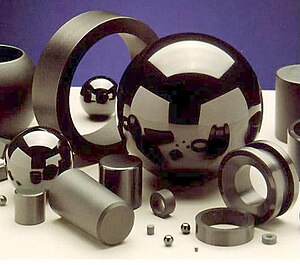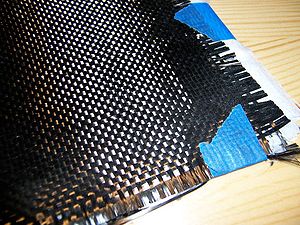Materials science: Difference between revisions
France3470 (talk | contribs) Disambiguated: filament → Fiber, wave mechanics → wave |
|||
| Line 51: | Line 51: | ||
== Classes of materials == |
== Classes of materials == |
||
qMaterials science encompasses various classes of materials, each of which may constitute a separate field. Materials are sometimes classified by the type of bonding present between the atoms: |
|||
# [[Ionic bond|Ionic crystals]] |
# [[Ionic bond|Ionic crystals]] |
||
# [[Covalent bond|Covalent crystals]] |
# [[Covalent bond|Covalent crystals]] |
||
Revision as of 15:32, 30 September 2010
This article includes a list of references, related reading, or external links, but its sources remain unclear because it lacks inline citations. (April 2009) |

Materials science is an interdisciplinary field involving the properties of matter and its applications to various areas of science and engineering. This scientific field investigates the relationship between the structure of materials at atomic or molecular scales and their macroscopic properties. It incorporates elements of applied physics and chemistry. With significant media attention focused on nanoscience and nanotechnology in recent years, materials science has been propelled to the forefront at many universities. It is also an important part of forensic engineering and failure analysis. Materials science also deals with fundamental properties and characteristics of materials.
History
The material of choice of a given era is often its defining point. Phrases such as Stone Age, Bronze Age, and Steel Age are examples of this. Originally deriving from the manufacture of ceramics and its putative derivative metallurgy, materials science is one of the oldest forms of engineering and applied science. Modern materials science evolved directly from metallurgy, which itself evolved from mining and (likely) ceramics and the use of fire. A major breakthrough in the understanding of materials occurred in the late 19th century, when the American scientist Josiah Willard Gibbs demonstrated that the thermodynamic properties related to atomic structure in various phases are related to the physical properties of a material. Important elements of modern materials science are a product of the space race: the understanding and engineering of the metallic alloys, and silica and carbon materials, used in the construction of space vehicles enabling the exploration of space. Materials science has driven, and been driven by, the development of revolutionary technologies such as plastics, semiconductors, and biomaterials.
Before the 1960s (and in some cases decades after), many materials science departments were named metallurgy departments, from a 19th and early 20th century emphasis on metals. The field has since broadened to include every class of materials, including: ceramics, polymers, semiconductors, magnetic materials, medical implant materials and biological materials (materiomics).
Fundamentals
In materials science, rather than haphazardly looking for and discovering materials and exploiting their properties, the aim is instead to understand materials so that new materials with the desired properties can be created.
The basis of materials science involves relating the desired properties and relative performance of a material in a certain application to the structure of the atoms and phases in that material through characterization. The major determinants of the structure of a material and thus of its properties are its constituent chemical elements and the way in which it has been processed into its final form. These characteristics, taken together and related through the laws of thermodynamics, govern a material’s microstructure, and thus its properties.
The manufacture of a perfect crystal of a material is currently physically impossible. Instead materials scientists manipulate the defects in crystalline materials such as precipitates, grain boundaries (Hall-Petch relationship), interstitial atoms, vacancies or substitutional atoms, to create materials with the desired properties.
Not all materials have a regular crystal structure. Polymers display varying degrees of crystallinity, and many are completely non-crystalline. Glasses, some ceramics, and many natural materials are amorphous, not possessing any long-range order in their atomic arrangements. The study of polymers combines elements of chemical and statistical thermodynamics to give thermodynamic, as well as mechanical, descriptions of physical properties.
In addition to industrial interest, materials science has gradually developed into a field which provides tests for condensed matter or solid state theories. New physics emerge because of the diverse new material properties which need to be explained.
Materials in industry
Radical materials advances can drive the creation of new products or even new industries, but stable industries also employ materials scientists to make incremental improvements and troubleshoot issues with currently used materials. Industrial applications of materials science include materials design, cost-benefit tradeoffs in industrial production of materials, processing techniques (casting, rolling, welding, ion implantation, crystal growth, thin-film deposition, sintering, glassblowing, etc.), and analytical techniques (characterization techniques such as electron microscopy, x-ray diffraction, calorimetry, nuclear microscopy (HEFIB), Rutherford backscattering, neutron diffraction, small-angle X-ray scattering (SAXS), etc.
Besides material characterization, the material scientist/engineer also deals with the extraction of materials and their conversion into useful forms. Thus ingot casting, foundry techniques, blast furnace extraction, and electrolytic extraction are all part of the required knowledge of a metallurgist/engineer. Often the presence, absence or variation of minute quantities of secondary elements and compounds in a bulk material will have a great impact on the final properties of the materials produced, for instance, steels are classified based on 1/10th and 1/100 weight percentages of the carbon and other alloying elements they contain. Thus, the extraction and purification techniques employed in the extraction of iron in the blast furnace will have an impact of the quality of steel that may be produced.
The overlap between physics and materials science has led to the offshoot field of materials physics, which is concerned with the physical properties of materials. The approach is generally more macroscopic and applied than in condensed matter physics. See important publications in materials physics for more details on this field of study.
The study of metal alloys is a significant part of materials science. Of all the metallic alloys in use today, the alloys of iron (steel, stainless steel, cast iron, tool steel, alloy steels) make up the largest proportion both by quantity and commercial value. Iron alloyed with various proportions of carbon gives low, mid and high carbon steels. For the steels, the hardness and tensile strength of the steel is directly related to the amount of carbon present, with increasing carbon levels also leading to lower ductility and toughness. The addition of silicon and graphitization will produce cast irons (although some cast irons are made precisely with no graphitization). The addition of chromium, nickel and molybdenum to carbon steels (more than 10%) gives us stainless steels.
Other significant metallic alloys are those of aluminium, titanium, copper and magnesium. Copper alloys have been known for a long time (since the Bronze Age), while the alloys of the other three metals have been relatively recently developed. Due to the chemical reactivity of these metals, the electrolytic extraction processes required were only developed relatively recently. The alloys of aluminium, titanium and magnesium are also known and valued for their high strength-to-weight ratios and, in the case of magnesium, their ability to provide electromagnetic shielding. These materials are ideal for situations where high strength-to-weight ratios are more important than bulk cost, such as in the aerospace industry and certain automotive engineering applications.
Other than metals, polymers and ceramics are also an important part of materials science. Polymers are the raw materials (the resins) used to make what we commonly call plastics. Plastics are really the final product, created after one or more polymers or additives have been added to a resin during processing, which is then shaped into a final form. Polymers which have been around, and which are in current widespread use, include polyethylene, polypropylene, PVC, polystyrene, nylons, polyesters, acrylics, polyurethanes, and polycarbonates. Plastics are generally classified as "commodity", "specialty" and "engineering" plastics.
PVC (polyvinyl-chloride) is widely used, inexpensive, and annual production quantities are large. It lends itself to an incredible array of applications, from artificial leather to electrical insulation and cabling, packaging and containers. Its fabrication and processing are simple and well-established. The versatility of PVC is due to the wide range of plasticisers and other additives that it accepts. The term "additives" in polymer science refers to the chemicals and compounds added to the polymer base to modify its material properties.
Polycarbonate would be normally considered an engineering plastic (other examples include PEEK, ABS). Engineering plastics are valued for their superior strengths and other special material properties. They are usually not used for disposable applications, unlike commodity plastics.
Specialty plastics are materials with unique characteristics, such as ultra-high strength, electrical conductivity, electro-fluorescence, high thermal stability, etc.
The dividing line between the various types of plastics is not based on material but rather on their properties and applications. For instance, polyethylene (PE) is a cheap, low friction polymer commonly used to make disposable shopping bags and trash bags, and is considered a commodity plastic, whereas Medium-Density Polyethylene MDPE is used for underground gas and water pipes, and another variety called Ultra-high Molecular Weight Polyethylene UHMWPE is an engineering plastic which is used extensively as the glide rails for industrial equipment and the low-friction socket in implanted hip joints.
Another application of material science in industry is the making of composite materials. Composite materials are structured materials composed of two or more macroscopic phases. Applications range from structural elements such as steel-reinforced concrete, to the thermally insulative tiles which play a key and integral role in NASA's Space Shuttle thermal protection system which is used to protect the surface of the shuttle from the heat of re-entry into the Earth's atmosphere. One example is Reinforced Carbon-Carbon (RCC), The light gray material which withstands reentry temperatures up to 1510 °C (2750 °F) and protects the Space Shuttle's wing leading edges and nose cap. RCC is a laminated composite material made from graphite rayon cloth and impregnated with a phenolic resin. After curing at high temperature in an autoclave, the laminate is pyrolized to convert the resin to carbon, impregnated with furfural alcohol in a vacuum chamber, and cured/pyrolized to convert the furfural alcohol to carbon. In order to provide oxidation resistance for reuse capability, the outer layers of the RCC are converted to silicon carbide.
Other examples can be seen in the "plastic" casings of television sets, cell-phones and so on. These plastic casings are usually a composite material made up of a thermoplastic matrix such as acrylonitrile-butadiene-styrene (ABS) in which calcium carbonate chalk, talc, glass fibres or carbon fibres have been added for added strength, bulk, or electro-static dispersion. These additions may be referred to as reinforcing fibres, or dispersants, depending on their purpose.
Classes of materials
qMaterials science encompasses various classes of materials, each of which may constitute a separate field. Materials are sometimes classified by the type of bonding present between the atoms:
- Ionic crystals
- Covalent crystals
- Metals
- Intermetallics
- Semiconductors
- Polymers
- Composite materials
- Vitreous materials
Overview
- Nanotechnology – rigorously, the study of materials where the effects of quantum confinement, the Gibbs-Thomson effect, or any other effect only present at the nanoscale is the defining property of the material; but more commonly, it is the creation and study of materials whose defining structural properties are anywhere from less than a nanometer to one hundred nanometers in scale, such as molecularly engineered materials.
- Microtechnology - study of materials and processes and their interaction, allowing microfabrication of structures of micrometric dimensions, such as MicroElectroMechanical Systems (MEMS).
- Crystallography – the study of how atoms in a solid fill space, the defects associated with crystal structures such as grain boundaries and dislocations, and the characterization of these structures and their relation to physical properties.
- Materials Characterization – such as diffraction with x-rays, electrons, or neutrons, and various forms of spectroscopy and chemical analysis such as Raman spectroscopy, energy-dispersive spectroscopy (EDS), chromatography, thermal analysis, electron microscope analysis, etc., in order to understand and define the properties of materials. See also List of surface analysis methods

- Metallurgy – the study of metals and their alloys, including their extraction, microstructure and processing.
- Biomaterials – materials that are derived from and/or used with biological systems.
- Electronic and magnetic materials – materials such as semiconductors used to create integrated circuits, storage media, sensors, and other devices.
- Tribology – the study of the wear of materials due to friction and other factors.
- Surface science/Catalysis – interactions and structures between solid-gas solid-liquid or solid-solid interfaces.
- Ceramography – the study of the microstructures of high-temperature materials and refractories, including structural ceramics such as RCC, polycrystalline silicon carbide and transformation toughened ceramics
Some practitioners often consider rheology a sub-field of materials science, because it can cover any material that flows. However, modern rheology typically deals with non-Newtonian fluid dynamics, so it is often considered a sub-field of continuum mechanics. See also granular material.

- Glass Science – any non-crystalline material including inorganic glasses, vitreous metals and non-oxide glasses.
- Forensic engineering – the study of how products fail, and the vital role of the materials of construction
- Forensic materials engineering – the study of material failure, and the light it sheds on how engineers specify materials in their product
- Textile Reinforced Materials - materials in the form of ceramic or concrete are reinforced with a primarily woven or non-woven textile structure to impose high strength with comparatively more flexibility to withstand vibrations and sudden jerks.
Primary topics
- Thermodynamics, statistical mechanics, and physical chemistry, for phase equilibrium conditions, phase diagrams of materials systems (multi-phase, multi-component, reacting and non-reacting systems)
- Phase transformation kinetics, for the kinetics of phase transformations (with particular emphasis on solid-solid phase transitions)
- Transport phenomena for the transport of heat, mass, and momentum in materials processing.
- Crystallography, quantum chemistry or quantum physics, for the structure (symmetry and defects) and bonding in materials (e.g., ionic, metallic, covalent, and van der Waals bonding)
- Mechanical behavior of materials, to understand the mechanical properties of materials, defects and their propagation, and their behavior under static, dynamic, and cyclic loads
- Electronic properties of materials, and solid-state physics, for the understanding of the electronic, thermal, magnetic, and optical properties of materials
- Diffraction and wave mechanics, for the science behind characterization systems, e.g., transmission electron microscopy (TEM)

- Polymer properties, synthesis, and characterization, for a specialized understanding of how polymers behave, how they are made, and how they are characterized; exciting applications of polymers include liquid crystal displays (LCDs, the displays found in most cell-phones, cameras, and iPods), novel photovoltaic devices based on semiconductor polymers (which, unlike the traditional silicon solar panels, are flexible and cheap to manufacture, albeit with lower efficiency), and membranes for room-temperature fuel cells (as proton exchange membranes) and filtration systems in the environmental and biomedical fields
- Biomaterials, physiology, biomechanics, biochemistry, for a specialized understanding of how materials integrate into biological systems, e.g., through materiomics
- Semiconductor materials and semiconductor devices, for a specialized understanding of the advanced processes used in industry (e.g. crystal growth techniques, thin-film deposition, ion implantation, photolithography), their properties, and their integration in electronic devices
- Alloying, corrosion, and thermal or mechanical processing, for a specialized treatment of metallurgical materials—with applications ranging from aerospace and industrial equipment to the civil industries
Professional organizations
- Materials Research Society, MRS
- ASM International
- The Minerals, Metals, & Materials Society, TMS
- Materials Australia
- American Ceramic Society, ACerS
- NACE International
- The American Institute of Mining, Metallurgical, and Petroleum Engineers, AIME
- Society for the Advancement of Material and Process Engineering, SAMPE
- The Institute of Materials, Minerals and Mining, IOM3
- Alpha Sigma Mu, ΑΣΜ
Important journals
- ACS Applied Materials & Interfaces
- Acta Crystallographica
- Acta Materialia
- Acta Metallurgica
- Advanced Composite Materials
- Advanced Functional Materials
- Advanced Materials
- Chemistry of Materials
- Computational Materials Science
- Crystal Growth & Design
- Federation of European Materials Science Societies Newsletter
- International Journal of Applied Ceramic Technology
- JOM
- Journal of the American Ceramic Society
- Journal of Applied Crystallography
- J Colloid & Interface Science
- Journal of Materials Chemistry
- Journal of Materials Research
- Journal of Materials Science
- Journal of Physical Chemistry B
- Materials Chemistry and Physics
- Materials Letters
- Materials Research Bulletin
- Materials Science and Engineering-A, B, C, and R
- Metallurgical and Materials Transactions
- Modelling and Simulation in Materials Science and Engineering
- MRS Bulletin
- Nature Materials
- Science and Technology of Advanced Materials - Open Access
See also
- Atomic packing factor
- Timeline of materials technology
- Bio-based materials
- Biomaterial
- Bioplastic
- Carbon nanotube
- Ceramic forming techniques
- Ceramic engineering
- Colloidal crystal
- Composite material
- Crystallography
- Electron crystallography
- Electron diffraction
- Liquid crystal
- Important publications in materials science
- List of emerging material science technologies
- List of scientific journals - Materials science
- List of software for nanostructures modeling
- List of publications in physics - Materials physics
- List of surface analysis methods
- List of thermal analysis methods
- Metallurgy
- Mineralogy
- Molecular design software
- Molecular modelling
- Nanomaterials
- Nanotechnology
- Neutron crystallography
- Neutron diffraction
- Phase Equilibria Diagrams database
- Quenching
- Sintering
- Sol-gel
- Solid-state chemistry
- Transparent materials
- Tribology
- X-ray crystallography
- X-ray diffraction
Bibliography
- Ashby, Michael (2007). Materials: engineering, science, processing and design (1st ed.). Butterworth-Heinemann. ISBN 978-0-7506-8391-3.
{{cite book}}: Unknown parameter|coauthors=ignored (|author=suggested) (help) - Askeland, Donald R. (2005). The Science & Engineering of Materials (5th ed.). Thomson-Engineering. ISBN 0-534-55396-6.
{{cite book}}: Unknown parameter|coauthors=ignored (|author=suggested) (help) - Callister, Jr., William D. (2000). Materials Science and Engineering - An Introduction (5th ed.). John Wiley and Sons. ISBN 0-471-32013-7.
- Eberhart, Mark (2003). Why Things Break: Understanding the World by the Way It Comes Apart. Harmony. ISBN 1-4000-4760-9.
- Gaskell, David R. (1995). Introduction to the Thermodynamics of Materials (4th ed.). Taylor and Francis Publishing. ISBN 1-56032-992-0.
- Gordon, James Edward (1984). The New Science of Strong Materials or Why You Don't Fall Through the Floor (eissue ed.). Princeton University Press. ISBN 0-691-02380-8.
- Mathews, F.L. & Rawlings, R.D. (1999). Composite Materials: Engineering and Science. Boca Raton: CRC Press. ISBN 0-8493-0621-7.
{{cite book}}: Check|isbn=value: checksum (help)CS1 maint: multiple names: authors list (link) - Lewis, P.R., Reynolds, K. & Gagg, C. (2003). Forensic Materials Engineering: Case Studies. Boca Raton: CRC Press.
{{cite book}}: CS1 maint: multiple names: authors list (link) - Wachtman, John B. (1996). Mechanical Properties of Ceramics. New York: Wiley-Interscience, John Wiley & Son's. ISBN 0-471-13316-7.
- Walker, P., ed. (1993). Chambers Dictionary of Materials Science and Technology. Chambers Publishing. ISBN 055013249X.
Further reading
- Timeline of Materials Science at The Minerals, Metals & Materials Society (TMS) - Accessed March 2007
- Burns, G. (1990). Space Groups for Scientists and Engineers (2nd ed.). Boston: Academic Press, Inc. ISBN 0-12-145761-3.
{{cite book}}: Unknown parameter|coauthors=ignored (|author=suggested) (help) - Cullity, B.D. (1978). Elements of X-Ray Diffraction (2nd ed.). Reading, Massachusetts: Addison-Wesley Publishing Company. ISBN 0-534-55396-6.
- Giacovazzo, C (1992). Fundamentals of Crystallography. Oxford: Oxford University Press. ISBN 0-19-855578-4.
{{cite book}}: Unknown parameter|coauthors=ignored (|author=suggested) (help) - Green, D.J. (1989). Transformation Toughening of Ceramics. Boca Raton: CRC Press. ISBN 0-8493-6594-5.
{{cite book}}: Unknown parameter|coauthors=ignored (|author=suggested) (help) - Lovesey, S. W. (1984). Theory of Neutron Scattering from Condensed Matter; Volume 1: Neutron Scattering. Oxford: Clarendon Press. ISBN 0-19-852015-8.
- Lovesey, S. W. (1984). Theory of Neutron Scattering from Condensed Matter; Volume 2: Condensed Matter. Oxford: Clarendon Press. ISBN 0-19-852017-4.
- O'Keeffe, M. (1996). Crystal Structures; I. Patterns and Symmetry. Washington, DC: Mineralogical Society of America, Monograph Series. ISBN 0-939950-40-5.
{{cite book}}: Italic or bold markup not allowed in:|publisher=(help); Unknown parameter|coauthors=ignored (|author=suggested) (help) - Squires, G.L. (1996). Introduction to the Theory of Thermal Neutron Scattering (2nd ed.). Mineola, New York: Dover Publications Inc. ISBN 0-486-69447-X.
- Young, R.A., ed. (1993). The Rietveld Method. Oxford: Oxford University Press & International Union of Crystallography. ISBN 0-19-855577-6.
External links
- Nanoscale Interdisciplinary Research Team
- CMR - Centre for Materials Research
- Materials Science and Engineering - Idaho National Laboratory
- Dissemination of IT for the Promotion of Materials Science (DoITPoMS)
- EURELNET Technology Transfer Department at the University of Bordeaux
- MATTER (Materials e-Learning Resources) at the University of Liverpool
- CORE-Materials Open Educational Resources for Materials Science & Engineering
